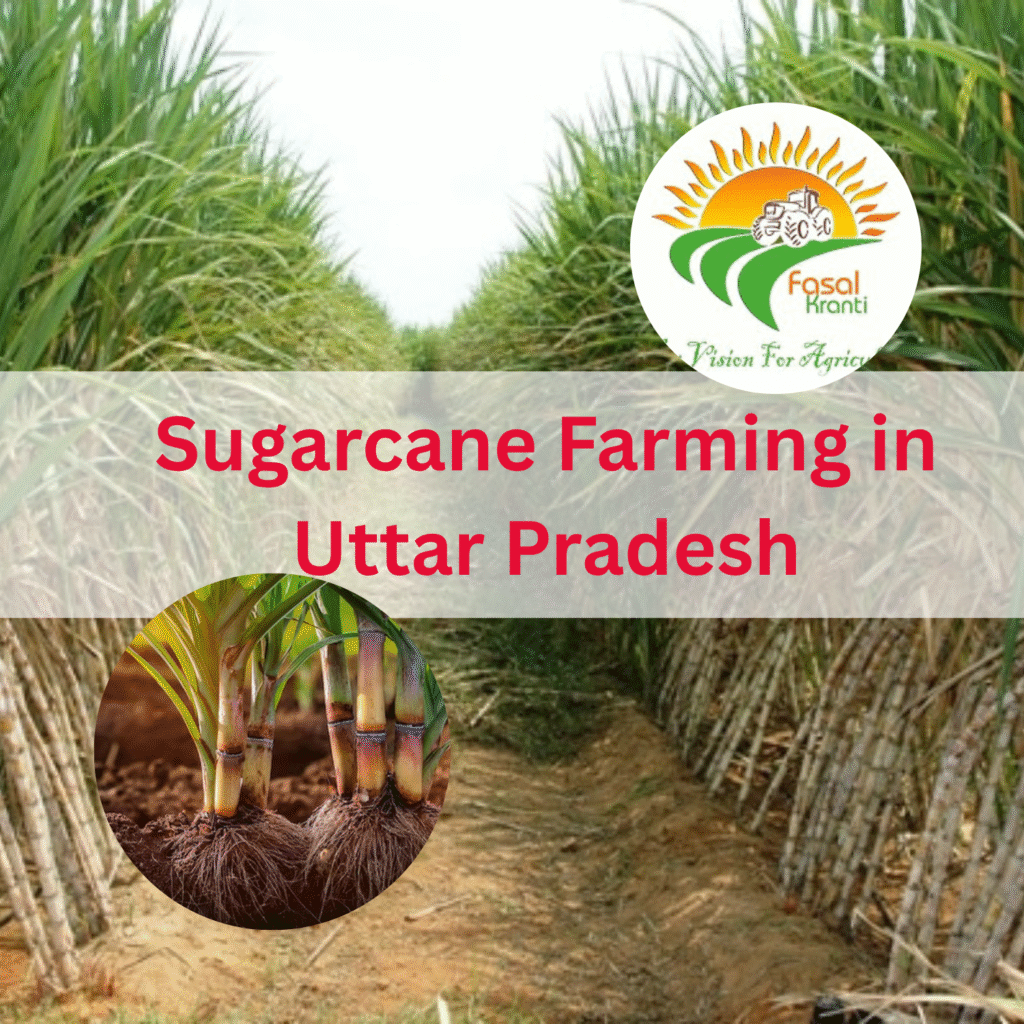
Sugarcane Farming in Uttar Pradesh has become a lifeline for millions of farmers across the state. As the leading sugarcane-producing state in India, Uttar Pradesh not only contributes a significant portion to the national output but also powers key industries like sugar, ethanol, jaggery, and bioenergy. With favorable agro-climatic conditions, robust infrastructure, and strong policy support, the state has emerged as a hub of commercial and sustainable sugarcane cultivation.
Uttar Pradesh: India’s Sugar Bowl
Uttar Pradesh accounts for nearly 40% of India’s sugarcane production, making it the highest contributor among all states. More than 23 lakh hectares of land are dedicated to sugarcane cultivation, supporting the livelihoods of over 45 lakh farmers. Districts like Muzaffarnagar, Meerut, Bijnor, Saharanpur, and Lakhimpur Kheri are renowned for their high-yielding farms and modern cane farming practices.
The state government has consistently supported the sector through fair and remunerative pricing (FRP), timely procurement, and financial assistance for irrigation, seed replacement, and mechanization. With over 120 operational sugar mills, farmers in the state have direct access to buyers, ensuring minimum wastage and better returns.
Why Sugarcane is a Preferred Crop in Uttar Pradesh
There are several reasons why sugarcane farming in Uttar Pradesh is highly profitable and preferred by small and large-scale farmers alike:
- High Yield Potential: With average yields ranging between 70–100 tonnes per hectare, sugarcane offers one of the highest per-acre returns.
- Multiple Uses: Beyond sugar, sugarcane is also used for ethanol, fodder, bio-compost, and organic jaggery production.
- Ratoon Advantage: Once sown, the same crop can be harvested multiple times through ratoon cropping, reducing sowing costs.
- Government Support: Financial schemes, subsidies on drip irrigation, crop insurance, and MSP assurance make sugarcane farming financially secure.
- Ethanol Economy Boost: As India aims to increase ethanol blending in fuel to 20% by 2025, demand for cane-based ethanol is growing rapidly, benefiting farmers directly.
Modern Practices in Sugarcane Farming in Uttar Pradesh
To make sugarcane farming more productive and eco-friendly, farmers are adopting advanced practices, including:
- Drip and Sprinkler Irrigation: These methods conserve water and improve cane quality.
- Soil Health Cards: Farmers test and manage nutrients based on soil condition to optimize yields.
- High-Yield Varieties: Varieties like Co-0238, Co-0118, and Co-15023 are popular among UP farmers for their early maturity and higher sugar content.
- Intercropping: Farmers grow sugarcane alongside mustard, potato, and pulses to maximize land use and income.
- Mechanized Harvesting: New machines are reducing labor dependency and speeding up harvest timelines.
Challenges Facing Sugarcane Farmers
Despite its success, sugarcane farming in Uttar Pradesh faces some persistent challenges:
- Water Intensive Nature: Sugarcane requires large amounts of water, putting pressure on groundwater reserves, especially in western UP.
- Delayed Payments: Some sugar mills delay farmer payments, leading to liquidity issues for growers.
- Pest and Disease Management: Red rot, wilt, and borers are common in sugarcane crops and need timely management.
- Mono-cropping Fatigue: Growing only sugarcane over years can reduce soil fertility unless crop rotation is practiced.
Government Initiatives to Strengthen Sugarcane Farming
The Uttar Pradesh government and the central government have rolled out several schemes to improve the sustainability and profitability of sugarcane farming:
- Ganna Tracking System: The E-Ganna app helps farmers receive real-time information on delivery schedules and payments.
- MSP and FRP Assurance: Minimum support prices and fair remunerative prices ensure income security.
- Ethanol Production Incentives: Sugar mills are encouraged to produce ethanol, creating a parallel revenue stream for farmers.
- Subsidy on Drip Irrigation: Farmers get financial aid for adopting water-saving technologies.
- Training by Krishi Vigyan Kendras (KVKs): Regular training camps update farmers on pest control, weather patterns, and soil management.
Future of Sugarcane Farming in Uttar Pradesh
The future of sugarcane farming in Uttar Pradesh lies in diversification, sustainability, and value addition. The growing demand for organic jaggery, packaged cane juice, and ethanol opens new doors for entrepreneurial farmers. With rising mechanization, digital monitoring, and government collaboration, sugarcane farming is set to become even more efficient and profitable.
The push toward carbon-neutral farming and bio-fuel adoption aligns perfectly with sugarcane’s eco-friendly processing potential. Integrated with new-age technology and global market opportunities, sugarcane farmers in UP can lead India’s green agricultural transformation.
Conclusion
Sugarcane farming in Uttar Pradesh is more than just a traditional agricultural activity; it is a strategic sector with immense economic and industrial importance. The synergy between government policies, farmer participation, and modern practices has placed Uttar Pradesh at the forefront of India’s sugar and ethanol revolution.
With continued innovation, timely payments, and focus on sustainability, sugarcane farming can unlock the next era of prosperity for the state’s rural economy creating jobs, increasing farmer incomes, and powering clean energy.